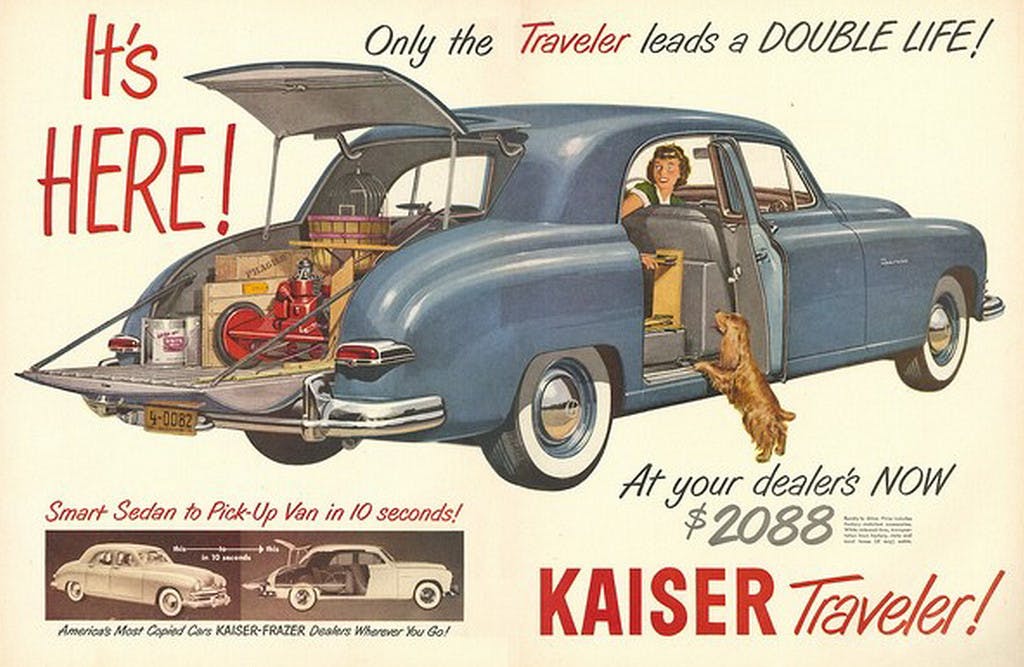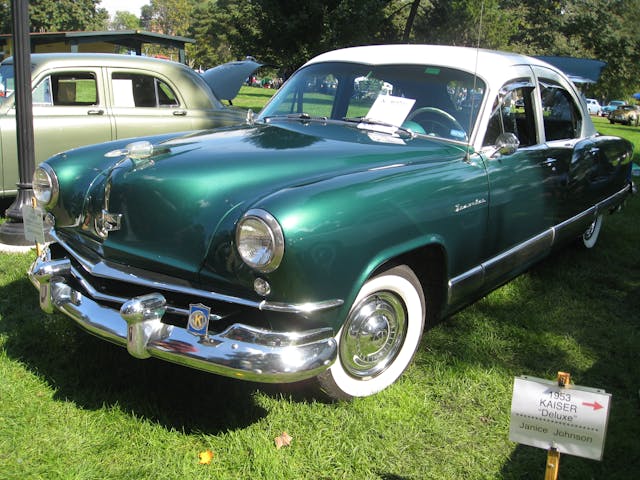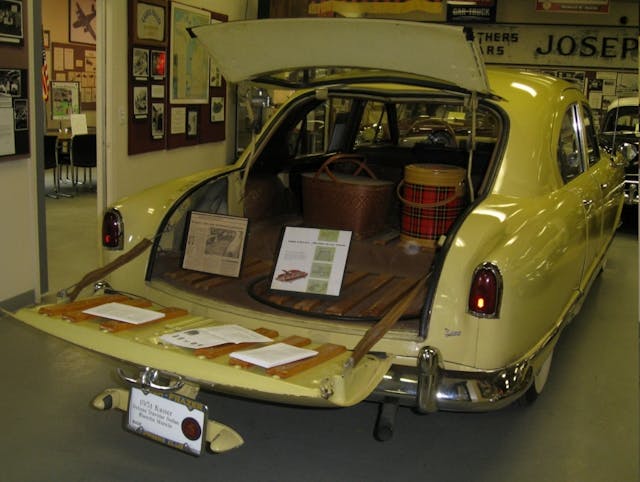Media | Articles
Kaiser-Frazer’s mid-century family cars were true “convertibles”
“Ahead of its time” is a phrase that can sometimes be offered up as an excuse for failure that sweeps away the root cause of the product’s demise. The Chrysler Airflow was indeed technologically advanced, but almost 90 years after its introduction, the snub-nosed saloon still looks funny. The 1948 Tucker has a number of features that Tucker enthusiasts say were futuristic and forward-thinking, but I challenge you to find me anything on a 2021 model year automobile that can be traced to the Tucker. No, the Tucker’s “safety cell” doesn’t count: It required the driver and passenger to duck under the dashboard in anticipation of a collision. Not exactly up to the level of Bela Barenyi’s work on crush zones or Nils Bohlin’s three-point safety harness.
Such a discussion brings to mind the Kaiser-Frazer Traveler and Vagabond models, produced from 1949 to 1953. Some call them the first hatchbacks, though I’m sure you can find earlier cars with rear-opening hatches. It’s possible, though, that “first crossover utility vehicles” might be a more apt description for those Kaiser-Frazers. They certainly seem to make more sense than today’s hiked-up and overweight CUVs.
Henry J. Kaiser was one of the most successful industrialists ever. If anyone could claim the title of “idea man,” it was Kaiser. Rumor went that he would average about 100 ideas an hour, though 99 of them weren’t any good. Still, that meant about eight good ideas in an average working day. Kaiser revolutionized shipbuilding, was a pioneer in the aluminum and health-insurance industries, and tried to sell compact cars before compact cars were cool. If you drive a Jeep today, you can thank him for saving the Willys-Overland corporation and keeping the Jeep brand alive in the 1950s and ’60s.
It is no exaggeration to say that Henry Kaiser also had a major role in the Allied victory in World War II. His shipyards embraced construction methods used in the auto industry to produce Liberty and Victory merchant ships that supplied Great Britain and the USSR in great enough quantities that they overwhelmed the German Kriegsmarine’s U-boats. It was Henry Kaiser who personally pitched U.S. Navy brass on making smaller “escort” carriers by putting aircraft decks on merchant marine hulls. The U.S. entered the war with just six fleet carriers—large warships that took years to build. Kaiser’s idea promised to greatly expand U.S. naval air power very quickly, but the admirals rejected Kaiser’s idea. They were concerned that the small carriers had little in the way of armor or heavy guns, but after a personal appeal by Kaiser to President Franklin Roosevelt, an initial order was placed for 50 ships.
Kaiser’s little carriers proved the critical difference in the Battle of the Leyte Gulf. When Admiral “Bull” Halsey’s fleet carriers were drawn away from the Philippines by a Japanese feint, it was up to three escort carrier groups to hold off the much more powerful Japanese armada. With air support from the other two escort carrier groups, Taffy 3, which consisted of six small escort carriers, three destroyers, and four destroyer escorts, faced off against four Japanese battleships (including Japan’s largest, the Yamato, with 18-inch guns), six heavy cruisers, two light cruisers, and 11 destroyers. Taffy 3 has gone down in naval history for the way its sailors, though outmanned and outgunned, courageously forced a superior Japanese force to withdraw, thus saving the American invasion of the Philippines.
Marketplace
Buy and sell classics with confidence
After the end of hostilities, Kaiser, like many other entrepreneurs, wanted to get into the car business to meet the consumer demand pent up after four years of war. He made a deal with Joseph Frazer, the CEO of the Graham-Paige car company, which had started circling the drain even before the war. The two set up production in the Willow Run plant, where Ford Motor Company had famously assembled B-24s at the rate of one every 55 minutes during the war. Kaiser-Frazer cars were well built and nicely styled, particularly after Kaiser hired Howard “Dutch” Darrin to do exterior design, and the company started off decently. Then again, in the immediate postwar era, demand was so great that you could practically sell anything with four wheels and an engine.
Like other postwar independents, Kaiser-Frazer was handicapped the lack of a modern, proprietary engine. As the Big Three automakers were introducing high-compression, overhead-valve V-8s, Kaiser-Frazer was using a flathead six it had bought from Continental whose design dated back to the 1920s. Kaiser-Frazer was also hamstrung by one of Henry Kaiser’s lesser ideas. While many automakers were introducing all-new models for 1949, Kaiser-Frazer was still using existing styling. Anticipating a drop in sales, Joseph Frazer wanted to cut production until its restyled cars were ready. Kaiser disagreed, kept up production volume, and the company lost millions of dollars. Frazer soon afterwards ceased active involvement in the company. By 1953, Kaiser-Frazer production stopped in the United States. (Assembly of “completely knocked down,” or CKD, kits of K-F cars continued in South America and in Israel.)
One of Henry Kaiser’s better ideas was the Traveler. Station wagons didn’t start out as mommy-mobiles. As the name indicates, they were meant to take people and their luggage to the train station, the luggage being almost as important as the passengers. The Kaiser-Frazer company didn’t have the money to develop a dedicated station-wagon body but still wanted to cater to that market. In addition, it hoped to attract traveling salesmen and businesses that might otherwise use what was called a “sedan delivery,” a car with a storage compartment instead of a back seat, or perhaps a panel truck. Kaiser came up with the idea of a convertible car, only this didn’t have a folding roof; it converted from a sedan to a cargo carrier.

In a Kaiser garage in Oakland, California, Henry traced cutlines on a dusty Kaiser sedan to show where he wanted Harvey Anscheutz, Kaiser-Frazer’s head of body development, to create two hinged panels that would open up the entire back end of the car for cargo. The upper panel, which swung up like a modern hatchback, included the rear window and the front half of the deck lid. The lower panel, which swung down, comprised the remainder of the decklid and the rear valence. About 200 changes needed to be made to the sedan body, suspension, and wiring to accomodate the conversion. Since the resulting opening was much larger than that in a conventional sedan, thus eliminating a stiffening rear cowl, substantial reinforcements had to be added to the all-steel body.
Perhaps the biggest challenge for Anscheutz, however, was complying with license-plate visibility laws in all 48 states. He came up with a clever, hinged license-plate holder that swung down when the lower hatch was open, keeping the plate visible at all times. Anscheutz also designed a way of folding the rear seat by tilting the cushion forward and lowering the seat back flat—an arrangement that is still in use in modern station wagons. That yielded a flat, seven-foot long cargo floor, finished smartly with wooden slats. To preserve cargo capacity, the full-size spare tire was originally mounted inside the left rear door, which was welded shut on most 1949 and 1950 models, though there’s a dummy door handle that still confuses some folks. 1951–53 Traveler and Vagabonds store the spare under the rear cargo floor.
At first, the Traveler and upscale Vagabond models performed pretty well, accounting for about one quarter of the more than 100,000 units that Kaiser-Frazer sold in 1949. For 1951, the Kaiser and Frazer models were restyled by Duncan McRae and Dutch Darrin and feature the latter’s characteristic “Darrin Dip” along the cars’ beltlines, along with “heart-shaped” front and rear glass. While the styling was less stodgy, there was also less cargo room and Traveler and Vagabond models didn’t sell as well, with just a few thousand finding homes between 1951 and 1953. Apparently there were also some quality control issues, since the company never managed to seal the rear openings to properly. Of course, by 1953, the company was more concerned with hemorrhaging cash than with leaking water.

While the Traveler and Vagabond were never huge sellers, they were influential. Until those models were introduced, station wagons were hardly stylish, usually a boxy wooden body mounted on a truck chassis. Though Kaiser-Frazer couldn’t afford to make an all-steel station-wagon, its Traveler popularized that idea.
General Motors and Ford Motor Company both bought Kaiser Travelers to tear down and analyze for any structural problems. Soon afterwards, by 1951 both companies introduced all-steel station wagon bodies, though Plymouth actually introduced an all-metal wagon in 1949, and the little Crosley station wagon, also with an all-steel body, debuted in 1947. Decades later, many of today’s crossover and SUVs, though far less shapely than these mid-century vehicles, owe a debt of gratitude to this humble, now defunct-company and the “idea man” who helped birth it.











